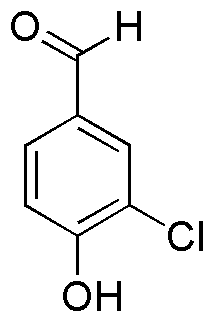3-Chloro-4-hydroxybenzaldehyde is widely utilized in research focused on:
- Pharmaceutical Development: This compound serves as an important intermediate in the synthesis of various pharmaceutical agents, particularly those targeting anti-inflammatory and analgesic properties.
- Organic Synthesis: It is frequently used in organic chemistry to create complex molecules, providing a versatile building block for researchers developing new compounds.
- Dyes and Pigments: The compound is applied in the production of dyes, contributing to vibrant colors in textiles and inks, which are essential in the fashion and printing industries.
- Biochemical Research: It plays a role in studying enzyme interactions and metabolic pathways, aiding researchers in understanding biological processes and disease mechanisms.
- Material Science: This chemical is explored for its potential in creating novel materials, such as polymers and coatings, which can enhance durability and performance in various applications.
General Information
Properties
Safety and Regulations
Applications
3-Chloro-4-hydroxybenzaldehyde is widely utilized in research focused on:
- Pharmaceutical Development: This compound serves as an important intermediate in the synthesis of various pharmaceutical agents, particularly those targeting anti-inflammatory and analgesic properties.
- Organic Synthesis: It is frequently used in organic chemistry to create complex molecules, providing a versatile building block for researchers developing new compounds.
- Dyes and Pigments: The compound is applied in the production of dyes, contributing to vibrant colors in textiles and inks, which are essential in the fashion and printing industries.
- Biochemical Research: It plays a role in studying enzyme interactions and metabolic pathways, aiding researchers in understanding biological processes and disease mechanisms.
- Material Science: This chemical is explored for its potential in creating novel materials, such as polymers and coatings, which can enhance durability and performance in various applications.
Documents
Safety Data Sheets (SDS)
The SDS provides comprehensive safety information on handling, storage, and disposal of the product.
Product Specification (PS)
The PS provides a comprehensive breakdown of the product’s properties, including chemical composition, physical state, purity, and storage requirements. It also details acceptable quality ranges and the product's intended applications.
Certificates of Analysis (COA)
Search for Certificates of Analysis (COA) by entering the products Lot Number. Lot and Batch Numbers can be found on a product’s label following the words ‘Lot’ or ‘Batch’.
Número de catálogo
Número de lote/lote
Certificates Of Origin (COO)
This COO confirms the country where the product was manufactured, and also details the materials and components used in it and whether it is derived from natural, synthetic, or other specific sources. This certificate may be required for customs, trade, and regulatory compliance.
Número de catálogo
Número de lote/lote
Safety Data Sheets (SDS)
The SDS provides comprehensive safety information on handling, storage, and disposal of the product.
DownloadProduct Specification (PS)
The PS provides a comprehensive breakdown of the product’s properties, including chemical composition, physical state, purity, and storage requirements. It also details acceptable quality ranges and the product's intended applications.
DownloadCertificates of Analysis (COA)
Search for Certificates of Analysis (COA) by entering the products Lot Number. Lot and Batch Numbers can be found on a product’s label following the words ‘Lot’ or ‘Batch’.
Número de catálogo
Número de lote/lote
Certificates Of Origin (COO)
This COO confirms the country where the product was manufactured, and also details the materials and components used in it and whether it is derived from natural, synthetic, or other specific sources. This certificate may be required for customs, trade, and regulatory compliance.


